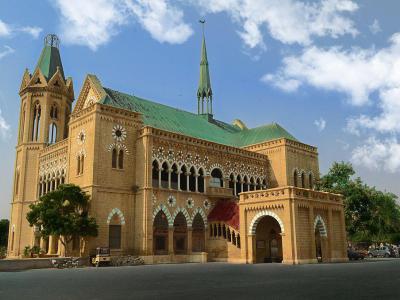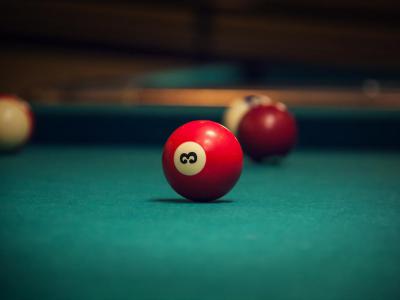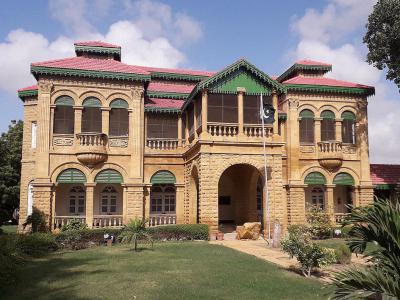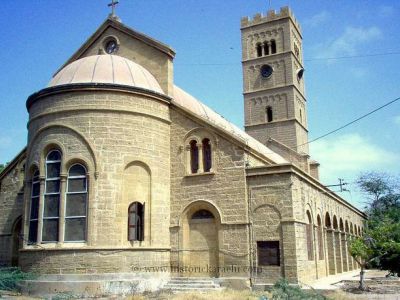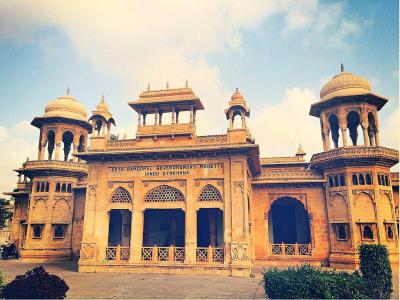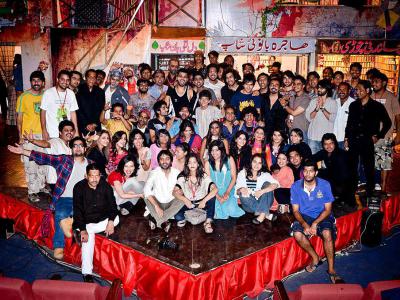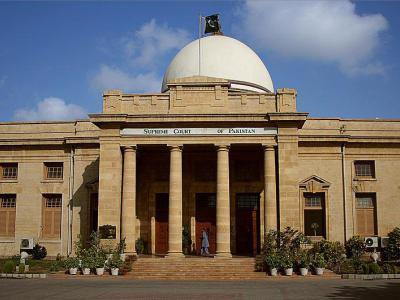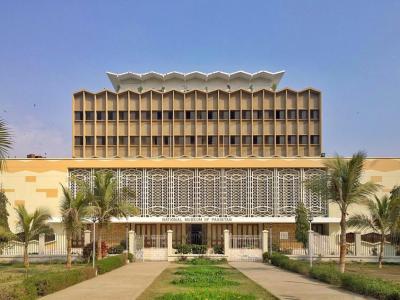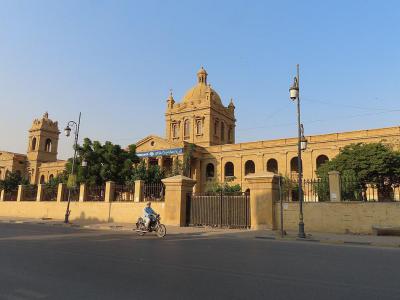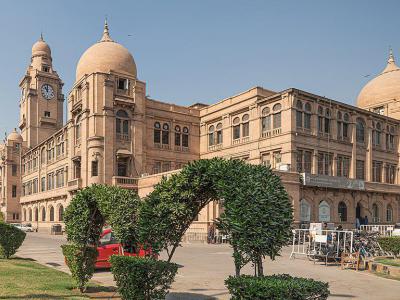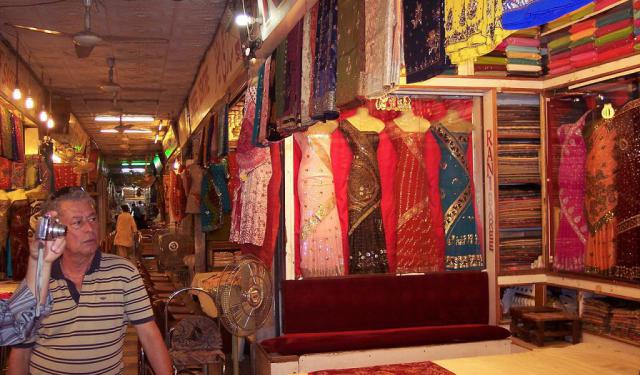Karachi's Architectural Jewels (Self Guided), Karachi
Despite the vague buildings throughout the city, Karachi is actually a region with a special cultural life. Karachi contains several sites which deserve the attention of tourists and local culture-loving habitants.
How it works: Download the app "GPSmyCity: Walks in 1K+ Cities" from Apple App Store or Google Play Store to your mobile phone or tablet. The app turns your mobile device into a personal tour guide and its built-in GPS navigation functions guide you from one tour stop to next. The app works offline, so no data plan is needed when traveling abroad.
Karachi's Architectural Jewels Map
Guide Name: Karachi's Architectural Jewels
Guide Location: Pakistan » Karachi (See other walking tours in Karachi)
Guide Type: Self-guided Walking Tour (Sightseeing)
# of Attractions: 10
Tour Duration: 2 Hour(s)
Travel Distance: 3.6 Km or 2.2 Miles
Author: Cathy
Sight(s) Featured in This Guide:
Guide Location: Pakistan » Karachi (See other walking tours in Karachi)
Guide Type: Self-guided Walking Tour (Sightseeing)
# of Attractions: 10
Tour Duration: 2 Hour(s)
Travel Distance: 3.6 Km or 2.2 Miles
Author: Cathy
Sight(s) Featured in This Guide:
- Frere Hall
- Sind Club
- Quaid-e-Azam House and Museum
- Holy Trinity Cathedral
- National Academy of Performing Arts
- Arts Council of Pakistan
- Supreme Court of Pakistan
- National Museum of Pakistan
- Dayaram Jethamal Science College
- Karachi Municipal Corporation
1) Frere Hall (must see)
Frere Hall is one of the few well-preserved buildings from the days of the British Raj that still exists in Karachi. It was built in honour of Sir Henry Bartle Edward Frere (1815–1884), who was known for promoting economic development in Karachi. From 2011 Frere hall is open to the public. On Sundays there is a book bazaar in the courtyards where it is possible to purchase some old out of print books amongst others. The rest of the week it is possible to visit the Sadequain gallery, home to the famous Sadequain mural called "Arz-o-Samawat." (Heaven and Earth).
Sight description based on Wikipedia.
2) Sind Club
The Sind Club is the oldest club located in Karachi. It was started in 1871 as an exclusive gentlemen' club. Although the province of Sindh is now spelled Sindh, the Sind Club still uses the old spelling given by its founders. It was an exclusive club for the Europeans, and natives were not allowed inside, almost till the independence of Pakistan in 1947. A competition was held to select the best design for the club. Richard Burton had warned against the use of Gothic architecture for the club building. Having seen Frere Hall he had said: "the Veneto-Gothic, so fit for Venice, so unfit for Karachi. It is to be hoped that the new club will not adopt Veneto-Gothic."
The first of the Sind Club buildings suits comfortably in its spacious grounds, its facade employing simple arcading which is composed of semi-circular openings on the ground and first floors, and terminates in pitched roofs. The other blocks, which were constructed later, generally follow the Indo-Italianate style of the original structure.
The first of the Sind Club buildings suits comfortably in its spacious grounds, its facade employing simple arcading which is composed of semi-circular openings on the ground and first floors, and terminates in pitched roofs. The other blocks, which were constructed later, generally follow the Indo-Italianate style of the original structure.
Sight description based on Wikipedia.
3) Quaid-e-Azam House and Museum (must see)
The Quaid-e-Azam House and Museum, earlier known as the Flagstaff House, is located on Fatima Jinnah Road. Just like almost all the other houses on the road, Quaid-eAzam was originally owned by a Parsi business tycoon. Father of the Nation, Quaid-i-Azam Mohammad Ali Jinnah, purchased the house on the eve of Independence and later Madar-i-Millat Mohtarma Fatima Jinnah lived here for many years. The building was designed by architect Moses Somake and likely built in 1890.
Sight description based on Wikipedia.
4) Holy Trinity Cathedral
The Holy Trinity Cathedral in Karachi is a church built for the non-Islamic population. The cathedral is also admired for its wonderful architecture and frescoes. Developed in the British Raj style, some of the plaques inside the Cathedral demonstrate scenes of British soldiers throughout the various wars.
5) National Academy of Performing Arts
The National Academy of Performing Arts is situated on M. R. Kiyani Road, opposite the Arts Council. The academy was constructed in 1925 on a plot of land measuring 47,000 square yards. The cupolas and balustrades are directly influenced and derived from the Mughal-Hindu mixed style which characterizes Akbar's Fatehpur Sikri. It is perhaps the only example of its type left in Karachi.
Sight description based on Wikipedia.
6) Arts Council of Pakistan
The Arts Council of Pakistan, or "Koocha-e-Saqafat", is a very popular site and landmark. The landmark is owned and funded by the government of Pakistan. It contains an amphitheater, exhibition hall, and other cultural attractions. The Arts Council is currently working on the promotion and development of Pakistanian art.
7) Supreme Court of Pakistan (must see)
The Supreme Court of Pakistan didn't have a stable place until the State Bank offered their venue. Before the bank, the building belonged to the Old Victoria Museum. The venue was considered fairly adequate, considering its colonial architecture and the location. The building was officially opened in February, 1997.
8) National Museum of Pakistan (must see)
National Museum of Pakistan was established in Frere Hall on April 17, 1950, replacing the defunct Victoria Museum. Frere Hall itself was built in 1865 as a tribute to Sir Bartle Frere, a Commissioner of Sind during the 19th century. Once the Museum was inaugurated then the Government of Pakistan deemed it wise to constitute an Advisory Council in 1950 with a primary duty to counsel the Museum on the issues of enriching its collection through new acquisitions and purchase of antiquities and works of Arts.
The Museum was shifted to the present premises in 1970. The basic objective of establishing National Museum was to collect, preserve, study, and exhibit the records of the cultural history of Pakistan and to promote a learned insight into the personality of its people. The Museum has a collection of 58,000 old coins (some dating from 74 Al-Hijra), and hundreds of well preserved sculptures. Some 70,000 publications, books and other reading material of the Archeology and Museums Department were also shifted to the National Museum so that general public could see them. Every year National Museum holds around a dozen exhibitions on National Days and other occasions.
The Museum was shifted to the present premises in 1970. The basic objective of establishing National Museum was to collect, preserve, study, and exhibit the records of the cultural history of Pakistan and to promote a learned insight into the personality of its people. The Museum has a collection of 58,000 old coins (some dating from 74 Al-Hijra), and hundreds of well preserved sculptures. Some 70,000 publications, books and other reading material of the Archeology and Museums Department were also shifted to the National Museum so that general public could see them. Every year National Museum holds around a dozen exhibitions on National Days and other occasions.
Sight description based on Wikipedia.
9) Dayaram Jethamal Science College
Inaugurated as Sindh Arts College by Lord Reay, Governor of Bombay, on January 17, 1882, the college was renamed D. J. Science College upon completion of the present structure in 1887. Located in the heart of old Karachi, the foundation stone for this college was laid in 1882. The cost of construction is reported to have been Rs.186,514 out of which the government contributed Rs. 97,193, the balance being raised through public donations. The college was by then a full-fledged institution with faculties of Arts, Sciences, Engineering and Law.
Sight description based on Wikipedia.
10) Karachi Municipal Corporation
The Karachi Municipal Corporation was initiated in 1927 and was finally finished in 1932. When the building celebrated its 75th anniversary recently, a decision was made to renovate the entire structure. The infrastructure presents several different domes which reflect Pakistanian tradition and style.
Walking Tours in Karachi, Pakistan
Create Your Own Walk in Karachi
Creating your own self-guided walk in Karachi is easy and fun. Choose the city attractions that you want to see and a walk route map will be created just for you. You can even set your hotel as the start point of the walk.
Shopping in Saddar
Karachi is city with a variety of shopping locations, yet its true charm lies in the bazaars (marketplaces). Karachi's most populated shopping area is Saddar. Saddar contains a large number of diverse markets and shops where people can find anything.
Tour Duration: 1 Hour(s)
Travel Distance: 1.7 Km or 1.1 Miles
Tour Duration: 1 Hour(s)
Travel Distance: 1.7 Km or 1.1 Miles
Karachi Downtown Walking Tour
Karachi is a huge, vibrant metropolis, one of Pakistan's most secular and socially liberal. The city boasts abundant and diverse architecture, comprising both contemporary and traditional Pakistani-style buildings, such as the Merewether Clock Tower and the National Museum of Pakistan. To explore these and other prominent sites of Karachi, follow this orientation walk.
Tour Duration: 3 Hour(s)
Travel Distance: 6.0 Km or 3.7 Miles
Tour Duration: 3 Hour(s)
Travel Distance: 6.0 Km or 3.7 Miles
The Most Popular Cities
/ view all



